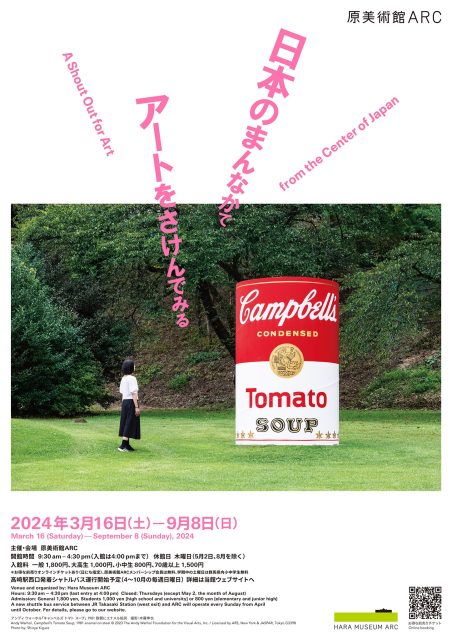
Hara Museum ARC organizes exhibitions each year that are thematically linked with some aspect of the museum’s unique role in the dissemination of art. For 2024, we are planning an exhibition of works selected from the Hara Museum and the Hara Rokuro Collections on the theme of “mannaka”, the Japanese word meaning “center” or “middle.”
Hara Museum ARC is located in the center of Japan. This “center,” however, is not the political or economic center that is Tokyo nor the cultural center that is Kyoto. It is Shibukawa in Gunma prefecture, which is referred to as the “city in the middle (or center) of Japan.”
What then is Shibukawa? It is a city that lies at the center of a circle that connects the northernmost and southernmost points of Japan’s four major islands. But more than this, it is a place that once flourished as a post town along the ancient highway Mikuni Kaido, a place that boasts the famous hot springs of Ikaho and views of the mountains of Akagi and Haruna where a unique culture has developed which includes the holding of the “Navel Festival” every summer. Other cities in Japan also lay claim to be the “center” or “heart” of Japan. This is to say, the position signified by the word “center” can change depending on the orientation or measuring stick being used.
The history of Hara Museum ARC began as an annex to the Hara Museum of Contemporary Art in Shinagawa, Tokyo. All operations moved to Hara Museum ARC when it became the sole venue after the closure of the Hara Museum in 2021. But unlike the Hara Museum, which focused mainly on special exhibitions, the focus of the ARC is on works from its permanent collection of contemporary and traditional East Asian art. Such a change from the center to the periphery might generally be seen in two ways: geographically (from Tokyo to Shibukawa) and thematically (from special exhibitions to permanent collection exhibitions).
Having lived through various natural disasters, the experience of art under a vast blue sky where one can breathe with a sense of security has assumed a central place in our thoughts and perspectives. And in light of the threats to the sustainability of the Earth, we believe our central role as a museum is not to organize exhibitions that involve large-scale advertising, staging and decoration, but rather to present the art we have collected and assembled on a relationship of trust with each of the artists.
Art is about thinking that shifts the center, i.e., the accepted wisdom, and the changing of the center is about standing on the periphery, i.e., the cutting edge. For the Hara Museum, being on the cutting edge meant preserving and perpetuating an abandoned pre-war Western-style structure as its venue within a Japanese milieu that favors the new; it meant adopting wood construction for Hara Museum ARC’s buildings at a time when reinforced concrete was the norm in public architecture; and most of all, it meant continuing to disseminate to Japan and the rest of the world contemporary art that had yet to be widely accepted. In this way, Hara Museum ARC intends to stay on the cutting edge, shouting out to art as a place at the center where all may come to encounter and become enchanted with art that is often relegated as a peripheral phenomenon.
■Theme by Gallery and Featured Artists and Works (slated)
-Gallery A: Trajectories of Thought
Tokihiro Sato, Shigeo Toya, Buckminster Fuller and others
-Gallery B: Fuzzy Boundaries
Arata Isozaki, Koji Enokura, Hiroshi Sugimoto, Jae-Eun Choi, Jan Fabre and others.
–Gallery C: Fluctuations of the Center
Masako Ando, Adriana Varejão, Yayoi Kusama, Kohei Nawa, Jonathan Borofsky, Yasumasa Morimura and others.
–Kankai Pavilion: Expansion
Hanshan and Shide, Gan’ku /Portrait of Lie Zi, Sesson / Nagasawa Rosetsu, A flock of sparrows / Landscape of Yodo River, Maruyama Okyo /Robert Mapplethorpe / Sumo match and others.
-Permanent Installations
Yayoi Kusama, Mirror Room (Pumpkin) /Yoshitomo Nara, My Drawing Room /Tatsuo Miyajima, Time Link /Yasumasa Morimura, Rondo (Twins) /Tabaimo, Midnight Sea /Yasuhiro Suzuki, Bench of the Japanese Archipelago and others.
-Outdoor Installations
Andy Warhol, Campbell’s Tomato Soup / Olafur Eliasson, SUNSPACE FOR SHIBUKAWA /Jean-Michel Othoniel, Kokoro /Nobuo Sekine, Phase in the Sky and others.
■Information
Title: A Shout Out for Art from the Center of Japan
Dates: Saturday, March 16 – Sunday, September 8, 2024
*One change of exhibited items will take place at the Kankai Pavilion during the exhibition.
Venue/Organized by: Hara Museum ARC
2855-1 Kanai, Shibukawa-shi, Gunma 377-0027
Tel: 0279-24-6585 E-mail: arc@haramuseum.or.jp official website: https://www.haramuseum.or.jp
Hours: 9:30 am – 4:30 pm (last entry at 4:00 pm)
Closed: Thursdays (except on May 2 and during the month of August)
Admission: General 1,800 yen (1,500 yen*), Students 1,000 yen (700 yen*) (high school and university) or 800 yen (500 yen*) (elementary and junior high) *Online booking price. For online discount tickets, go to https://www.e-tix.jp/haramuseum_arc/en/
*Free for Hara Museum ARC members / For residents of Gunma Prefecture: Free admission for elementary and junior high school children every Saturday during the school term.
